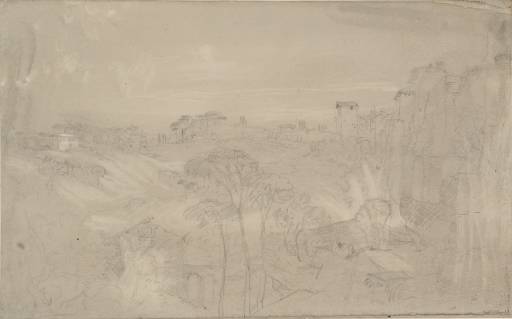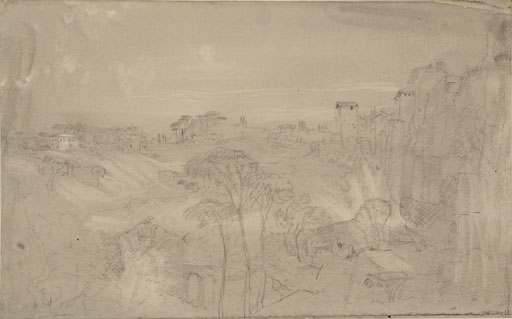Joseph Mallord William Turner View of the Muro Torto, Rome, with the Casino di Raffaello and Casino delle Rose 1819
Image 1 of 2
Joseph Mallord William Turner,
View of the Muro Torto, Rome, with the Casino di Raffaello and Casino delle Rose
1819
Joseph Mallord William Turner 1775–1851
View of the Muro Torto, Rome, with the Casino di Raffaello and Casino delle Rose 1819
D16344
Turner Bequest CLXXXIX 18
Turner Bequest CLXXXIX 18
Pencil and grey watercolour wash on white wove ‘Valleyfield’ paper, 231 x 370 mm
Stamped in black ‘CLXXXIX 18’ bottom right
Stamped in black ‘CLXXXIX 18’ bottom right
Accepted by the nation as part of the Turner Bequest 1856
Exhibition history
1904
National Gallery, London, various dates to at least 1904 (270).
References
1904
E.T. Cook and Alexander Wedderburn (eds.), Library Edition: The Works of John Ruskin: Volume XIII: Turner: The Harbours of England; Catalogues and Notes, London 1904, no.270, pp.384, 622, as ‘Rome’.
1909
A.J. Finberg, A Complete Inventory of the Drawings of the Turner Bequest, London 1909, vol.I, p.562, as ‘Rome. 270, N.G.’.
1920
D[ugald] S[utherland] MacColl, National Gallery, Millbank: Catalogue: Turner Collection, London 1920, p.87.
2011
Nicola Moorby, ‘Turner’s Sketches for “Rome from the Vatican”: Some Recent Discoveries’, Turner Society News, no.115, Spring 2011, pp.8, 9, reproduced fig.8.
The subject of this study is a view of the gardens of the Villa Borghese in Rome with the Muro Torto [Crooked or Twisted Wall], the wall which runs along the western perimeter of the park, between the Porta del Popolo and the Porta Pinciana. Turner’s drawing looks south-east towards the Casino di Raffaello [Casino of Raphael], a small summer-house, so called owing to the ‘school of Raphael’ frescoes which adorned the interior. Also variously known over the decades as the Villetta Doria, the Casino Olgiati, or the Casino Bevilacqua e Nelli, after its changing owners, the building stood in the Galoppatoio area of the Borghese Gardens but was completely destroyed during the siege of Rome in 1849.1 The frescoes, which had fortuituously been removed in 1836, can today be seen in the Galleria Borghese.2A detailed description of its appearance was recorded by Charlotte Eaton in her book, Rome in the Nineteenth Century, first published in 1820:
Since I have been in Rome, many are the visits I have paid to the Casino of Raphael, which was the chosen scene of his retirement, and adorned by his genius. It is about half a mile from the Porta del Popolo. The first wooden gate in the lane, on the right of the entrance into the grounds of the Villa Borghese, leads you into a vineyard, which you cross to the Casino di Raffaello; for it still bears his name, though it now belongs to Signore Nelli. It is unfurnished, except with casks of wine, and uninhabited except by a Contadina, who shows it to strangers. We passed through two rooms, painted by his scholars; the third, which was his bedroom, is entirely adorned with the work of his own hands. It is a small pleasant apartment, looking out on a little green lawn, fenced in with wood irregularly planted. The walls are covered with arabesques, in various whimsical and beautiful designs, – such as the sports of children; Loves balancing themselves on poles, or mounted on horseback, full of glee and mirth; Fauns and Satyrs; Mercury and Minerva; flowers and curling tendrils, and every beautiful composition that could suggest itself to a mind of taste, or a classic imagination, in its most sportive mood. It is impossible to describe to you the spirit of these designs. The cornice is supported by painted Carayatides. The coved roof is adorned with four medallions, containing portraits of his mistress, La Fornarina – it seemed as if he took pleasure in multiplying that beloved object, so that wherever his eyes turned her image might meet him. There are three other paintings ... The last, and best, of these paintings represents the nuptials of Alexander the Great, and Roxana ... in general he painted for others, – here he painted for himself – and it is interesting to see those sports of his mind, and to trace the fond delight with which he amused his leisure hours in decorating his home, the scene of his pleasures.3
As Eaton’s text indicates, the house was one of a number of Roman sites popularly believed during the nineteenth century to have been connected to Raphael (1483–1520). This made it a celebrated landmark for artists and tourists to the city. The building is the subject of a famous painted tondo by Jean Auguste Dominique Ingres (1780–1867), Le Casin de Raphael 1806–7 (Musée des Arts Décoratifs, Paris) and a related drawing, circa 1806–20 (Musée Ingres, Montauban),4 and see also views by Jean-Baptiste-Camille Corot (1796–1875),5 and an anonymous painting dated circa 1814, in the collection of the Museo di Roma.6 Turner made several sketches of the Casino in the St Peter’s sketchbook (see Tate D16232–D16239; Turner Bequest CLXXXVIII 43–46a), depicting the building from a variety of angles. It also appears as the subject of the landscape ‘picture-within-a-picture’ in Rome, from the Vatican exhibited 1820 (Tate, N00503).7 Turner shared the nineteenth-century fascination with Raphael and during his 1819 visit to Rome sketched a number of subjects owing to their supposed association with the artist: for example, the statue of Jonah in the Chigi Chapel, (see Tate D16240; CLXXXVIII 47); the façade of the Palazzo Vidoni-Caffarelli, (see D16271; Turner Bequest CLXXXVIII 63a); and the Casa Cenci, another building in the Borghese Gardens popularly believed to be have been used by Raphael, (see Tate D16302; Turner Bequest CLXXXVIII 79). The culmination of his interest was Rome, from the Vatican, a large oil painting exhibited during the tercentenary of the artist’s death. The composition of another view of the casino (see Tate D16237; Turner Bequest CLXXXVIII 45a) bears a strong resemblance to the so-called ‘Claudian’ landscape prominent in the foreground of the painting and inscribed along its lower edge, ‘Casa di Raffaello’.8
Turner’s drawing reflects a characteristic prospect of the Casino di Raffaello seen from the north-west, with the adjacent Casino delle Rose (also known as Villa Manfroni), the present-day Casa del Cínema. Dominating the right-hand side is the Muro Torto and dotted throughout the landscape are some of the many Mediterranean pines which characterised the gardens. Related sketches can be found in the St Peter’s sketchbook (see Tate D16236 and D16239; Turner Bequest CLXXXVIII 45 and 46a). Many other artists depicted a similar view, see for example, Thomas Jones (1742–1803)9, Penry Williams (1802–1885),10 and Johann Wilhelm Schirmer (1807–1863).11 Like many pages within this book, the design has been executed over a washed grey background. Turner has created areas of pale highlights by lifting or rubbing through to the white paper beneath, principally to make the Raphael’s Casino stand out from the rest of the composition.
Paola della Pergola, Cataloghi dei Musei e Gallerie d’Italia: Galleria Borghese: I Dipinti, vol.II, Rome 1959, nos.180–2, reproduced.
Charlotte Anne Eaton, Rome in the Nineteenth Century, vol.III, 2nd edition, Edinburgh 1822, pp.102–4.
See Hans Naef, Ingres in Rome, exhibition catalogue, National Gallery of Art, Washington 1971, pp.3 and 17, nos.1 and 21, reproduced.
See Alberta Campitelli (ed.), Villa Borghese: I principi, le arti, la città dal Settecento all’Ottocento, exhibition catalogue, Villa Poniatowski, Rome 2003, no.81, reproduced.
Martin Butlin and Evelyn Joll, The Paintings of J.M.W. Turner, revised ed., New Haven and London 1984, no.228.
See the on-line collection of the British Museum, http://www.britishmuseum.org/research/search_the_collection_database/search_object_image.aspx , accessed October 2009.
See Raphael's residence in the Campagna di Roma in a letter dated 27 March 1827, Royal Academy of Arts, London, 04/1633, see http://www.racollection.org.uk/ , accessed February 2009.
Verso:
?Blank (pasted to mount).
Nicola Moorby
October 2009
How to cite
Nicola Moorby, ‘View of the Muro Torto, Rome, with the Casino di Raffaello and Casino delle Rose 1819 by Joseph Mallord William Turner’, catalogue entry, October 2009, in David Blayney Brown (ed.), J.M.W. Turner: Sketchbooks, Drawings and Watercolours, Tate Research Publication, December 2012, https://www


